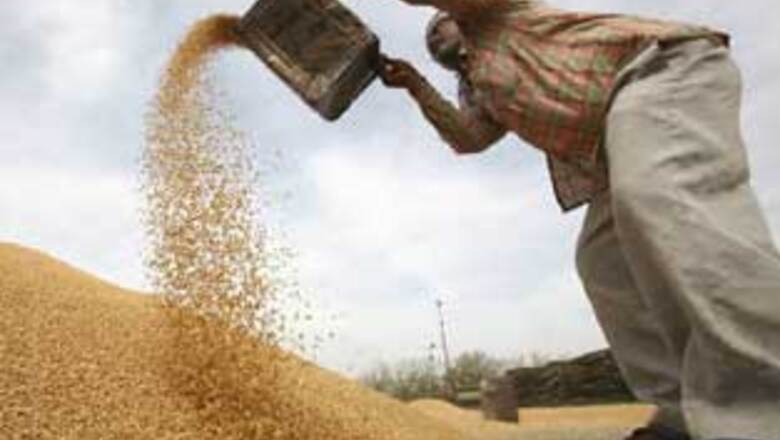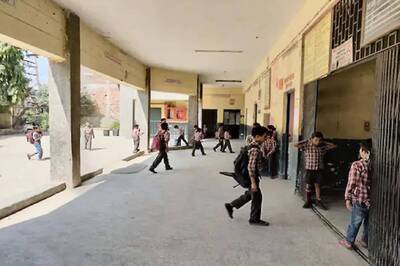
views
New Delhi: Just as India's sugar, soybean and rice farmers begin to breathe easier as the worst monsoon in nearly four decades winds down on a less sombre note, those planning to grow winter wheat are bracing for a serious knock-on impact.
The world's second-biggest wheat producer faces a grim winter: soil moisture is extremely low after summer rains delivered one-quarter less water than normal; hydro-reservoirs are deeply depleted, threatening power shortages and limiting irrigation; and many farmers may shift to planting more profitable rapeseed, which can better withstand dry conditions.
While the government ponders a broader policy response to the ravaged summer rice harvest and a sugar supply shortfall that will force the top consumer into a second year of substantial imports, analysts and traders warned that the worst fallout from the near-failure of the monsoon may not be past.
"The government needs to be better prepared for (these winter) crops. It was caught unaware by scanty rains this summer," said Head of research at Agriwatch, a commodity research firm S Raghuraman.
At the moment, the outlook still hinges heavily on September rains, essential for ensuring soil moisture is sufficient to support the wheat and rapseed crops, and that reservoirs rise to provide enough water to irrigate the crops, particularly in north and northwest India, where rain deficiency was 37 per cent last week.
But the precedent is not good. Although the summer-sown crops are much more heavily dependent on the June-September monsoon than the winter crops - three-quarters of India's annual rainfall comes from the monsoon - the latter have consistently declined almost as severely each year that the monsoon fails to deliver.
In 2002, when monsoon rainfall was 19 per cent below normal, winter crop output fell 13 per cent, after the summer crop contracted 22 per cent; in 1979, which saw a similar rain deficit, the decline was 19 per cent in summer and 14 per cent in winter. Output of wheat, which accounts for 60 per cent of the total winter crop area, fell 10 per cent in both years.
Contrarian Rapeseed
Farmers will be considering which winter crops to grow over the next two months, with the first indication of planting intentions likely to emerge once the government sets the minimum price it will guarantee to pay farmers for their wheat, probably before planting begins in mid-October.
It isn't all bad news - the rapeseed crop, which supplies about 15 per cent of India's demand for vegetable oil, may actually benefit as farmers allocate more space to grow a crop that requires less water and yields more income. The premium for Chicago Board of Trade soybeans over wheat has risen this summer to near the record high reached in 2008, and far above the average since 2000.
PAGE_BREAK
"A higher market price for rapeseed is likely to push up sowing area this winter. There could also be shift in area from wheat to rapeseed, which needs less water," said President of the Oil Millers and Traders Association in North Rajasthan, Jyoti Kanda.
The impact for global markets may not be immediate: while India produces as much as one-fifth of the world's wheat, that's normally enough to meet its demand. While its sudden need for imports in 2006 was one of the catalysts for wheat's rally, New Delhi has since then amassed enough wheat and rice stocks to feed its 1.1 billion people for 13 months, helped by bumper harvests and tight export curbs for both crops in the past two years.
Grain bins were so full that the government relaxed that ban briefly in July, although it reimposed the restriction less than two weeks later on bad news from the weather office. A trader at an international grains trading firm said India would be comfortable even if wheat output fell by 10 million tonnes from last year's record 80.6 million tonnes.
Double hit for wheat
The main focus will be on Punjab and Haryana, key states that typically produce a third of India's harvest, with traders bracing for lower planting and reduced yields after soil moisture was depleted by deficient summer rainfall.
"Talking about the harvest of 2010 will be a little early but what we know as of now is that soil moisture will not be good in states like Uttar Pradesh and Madhya Pradesh," said President of the Roller Flour Millers' Federation of India, M K Duttaraj president.
Uttar Pradesh accounts for a third of both the crop area and output, but consumes most of the grain, while Punjab produces 22 per cent of Indian wheat from 12 per cent of the crop area and is the biggest contributor to the national stockpile. The late arrival of the monsoon, which delivered the lowest June rainfall in 83 years, has prompted many farmers in the region to plant late-sown varieties of rice, which need less water, but this will also delay the wheat harvest and subsequent wheat planting, hurting yields.
In Haryana, the government is subsidising sowing of a variety of rapeseed, which can be planted now, to make up for destroyed rice fields, but it will mature late and either rule out wheat sowing or delay it to the fag end of the season, hitting output.
The situation may be worse in other wheat producing states, which have poor irrigation, as low rainfall has retarded the flow of water into Indian reservoirs at a time when they are normally being replenished to keep hydropower and irrigation canals working until the next year's monsoon.
Water level in Indian reservoirs rose to just 42 per cent of capacity in the week to August 27, far below the 10-year average of 57 per cent, government data showed last week. "Area under wheat is (likely to be) slightly lower compared to last year, but actual production will depend on how much water is available in the districts fed by canals," said Joint Director with Punjab Agriculture Department, Gurdial Singh.
September rainfall will be the last chance for these reservoirs to fill up before the rainy season ends, but rainfall in that month is usually barely 20 per cent of total monsoon rains, and the El Nino phenomenon - present this year, but thus far seen as weak to moderate - may make matters worse.
"There are indications of a developing El Nino, and if it intensifies, there could be a problem for winter-sown crops as well," Raghuraman said.




















Comments
0 comment